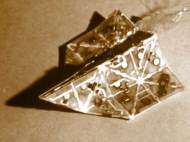Origami inspired shape-shifting robots from MIT
 By combining origami and electrical engineering, researchers at MIT and Harvard are developing a transformable robot. The researchers have developed algorithms that, given a three-dimensional shape, can determine how to reproduce it by folding a sheet of semi-rigid material with a distinctive pattern of flexible creases. To test out their theories, they built a prototype that can automatically assume the shape of either an origami boat or a paper airplane.
By combining origami and electrical engineering, researchers at MIT and Harvard are developing a transformable robot. The researchers have developed algorithms that, given a three-dimensional shape, can determine how to reproduce it by folding a sheet of semi-rigid material with a distinctive pattern of flexible creases. To test out their theories, they built a prototype that can automatically assume the shape of either an origami boat or a paper airplane.
Professor Daniela Rus, director of the Distributed Robotics Laboratory at the Computer Science and Artificial Intelligence Laboratory (CSAIL), researches systems of robots that can work together to tackle complicated tasks. One of the big research areas in distributed robotics is what’s called “programmable matter” – the idea that small, uniform, robots could snap together like intelligent Legos to create larger, more versatile robots.
Erik Demaine, also from CSAIL with research areas is the mathematics of origami, and Rus hatched the idea of a flat sheet of material with tiny robotic muscles, or actuators, which could fold itself into useful objects. In principle, flat sheets with flat actuators should be much easier to fabricate than three-dimensional robots with enough intelligence that they can locate and attach to each other.
About a year ago, Demaine and several colleagues — including his dad, who’s a visiting scientist at CSAIL, master’s student Aviv Ovadya, and Nadia Benbernou, a PhD student in applied mathematics who’s a coauthor on the new paper — proved that a large enough sheet creased in what’s called the “box pleat pattern” could be folded into a close approximation of any possible three-dimensional shape. The box pleat pattern divides the sheet into squares, each of which has a diagonal crease across it; but if two squares share an edge, their diagonal creases are mirror images. This paper marked the first time that the universality of a crease pattern had been shown, although Demaine and his collaborators have since proved that other crease patterns are universal as well.
Based on this result, Demaine, Rus, Harvard’s Robert Wood, and others developed algorithms that, given an arbitrary three-dimensional shape, could generate a sequence of folds that would produce it from a box-pleated sheet. They designed yet another set of algorithms that, given sequences of folds for several different shapes, would determine the minimum number of actuators necessary to produce all of them. Then they set about building a robot that could actually assume multiple origami shapes.
Their prototype, made from glass-fiber and hydrocarbon materials, with an elastic plastic at the creases, is divided into 16 squares about a centimeter across, each of which is further divided into two triangles. The actuators consist of a shape-memory alloy (a metal that changes shape when electricity is applied to it). Each triangle also has a magnet in it, so that it can attach to its neighbors once the right folds have been performed.
“You could imagine downloading the new iPhone,” Demaine says. “In the same way that you download the latest CD from your favorite artist totally electronically, you could imagine downloading shapes electronically, and programming hardware the same way you program software.”
Since it’s possible to build either a similar sheet with much smaller moving parts, or a larger sheet with similar-sized moving parts, the implementation of this technology could surpass shape-shifting robots and could be used for future tents that could adapt their shape according to the wind or solar cells that could adjust their shape in order to absorb optimal amount of energy. For more information read their paper: “Programmable matter by folding”.









Leave your response!